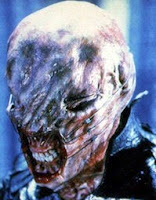HAMMER's THE REVENGE OF FRANKENSTEIN - a direct sequel to THE CURSE OF FRANKENSTEIN scripted by Jimmy Sangster - consolidated the feel of Hammer Horror. The Baron (Peter Cushing) has also undergone a rethink, changing from the aloof and self absorbed into a visionary, becoming the obsessive that we would become familiar. The film begins with hunchbacked Karl (Oscar Quitak) helping the Baron escape the guillotine, with Frankenstein promising him a new body. Michael Gwynn is cast as the physical form which incorporates the brain of Karl, remaining sympathetic even after developing cannibalistic tendencies. His emotional confrontation with Frankenstein at a dinner party, which ultimately exposes the Baron's true identity, is as moving as anything Hammer ever achieved. Elsewhere, performances are equally solid, particularly from Francis Matthews as the Baron's assistant Hans Kleve who, it's interesting to note, has the only real success in creating an artificial man in the entire cycle. Curiously, THE REVENGE OF FRANKENSTEIN has rarely achieved the level of analysis bestowed on others in the series, particularly in its pointed portrayal of the middle class medical elite using the impoverished working class as a mass donor bank.
The next film, THE EVIL OF FRANKENSTEIN, sits uncomfortably among the Hammer cannon, and the title is a complete misnomer, for the Baron was never less evil than here. Frankenstein (Cushing) discovers his original monster (Kiwi Kingston) perfectly preserved inside a mountain glacier attended by feral deaf-mute Rena (Katy Wild). The Baron gives his monster renewed life, but its brain has been traumatised by gunfire. A circus comes to Carlstaad, featuring the mesmerist Zoltan (Peter Woodthorpe), whom the Baron recruits to stimulate the creature's brain. But when officials order Zoltan out of town for operating without a licence, he uses his mesmeric hold over the monster to exact revenge.
The next film, THE EVIL OF FRANKENSTEIN, sits uncomfortably among the Hammer cannon, and the title is a complete misnomer, for the Baron was never less evil than here. Frankenstein (Cushing) discovers his original monster (Kiwi Kingston) perfectly preserved inside a mountain glacier attended by feral deaf-mute Rena (Katy Wild). The Baron gives his monster renewed life, but its brain has been traumatised by gunfire. A circus comes to Carlstaad, featuring the mesmerist Zoltan (Peter Woodthorpe), whom the Baron recruits to stimulate the creature's brain. But when officials order Zoltan out of town for operating without a licence, he uses his mesmeric hold over the monster to exact revenge.
New Zealand wrestler Kiwi Kingston is the “Cornflake Box” creature of THE EVIL OF FRANKENSTEIN. Kingston reunited with Hammer and Freddie Francis in the murder mystery HYSTERIA a year later.
Previous entries were skilfully directed by Terence Fisher; THE EVIL OF FRANKENSTEIN was helmed by Freddie Francis, and legend has it that Fisher was temporarily relieved of his duties as punishment for the commercial failure of THE PHANTOM OF THE OPERA. Whatever the reason, it is a rogue entry which negates the genetic advancements made by Fisher by forcing an ill-advised return to the feel of Golden Age Horror. The film was made for Universal, and consequently has an emphasis on ruined castles, sparkling lab equipment, villagers and burgomasters, which recall the American studio rather than the bloody tragedies of Hammer; also the Creature make-up design is very Karloffesque).
The Hammer Frankensteins were always superior over the Christopher Lee Draculas thanks to Cushing; he was always the glue that held them together, his coldly articulate Baron pitch-perfect for FRANKENSTEIN MUST BE DESTROYED, which shows an England struggling under the environmental weight of lunatic asylums and abandoned estates. On the run from the police, Frankenstein blackmails Anna Spengler (Veronica Carlson) and her fiancé Karl Holst (Simon Ward) into helping him kidnap his former colleague Dr Brandt (George Pravda) from a sanatorium. Anxious to exploit Brandt's knowledge, the scientist cures his insanity and after death transplants his brain into the body of Dr Richter (Freddie Jones). Unable to communicate with his "widow" Ella (Maxine Audley), the "new" Brandt is determined to kill his tormentor.
Fisher's FRANKENSTEIN MUST BE DESTROYED comes closest of all to Mary Shelley's original concept. For the first time, the Baron's creation is a sensitive, misunderstood being who finally turns the tables on his maker. Here, Frankenstein avenges himself not only on the medical establishment but also on womanhood. Given that he is working on projects which, in effect, excludes women from the creation of life, it's perhaps understandable that he should treat women with increasing disdain. In FRANKENSTEIN CREATED WOMAN, it was a female who unsportingly terminated his experiment by taking her own life. Now he systematically turns on all women, raping and killing Anna and treating a traumatised Ella Brandt with emotional sadism. It is Cushing at his finest, a genuinely frightening performance matched in its quality by Jones's moving turn as the bewildered Richer/Brandt. That Frankenstein himself is now the monster couldn’t be clearer.
"Scientist … Surgeon … Madman … Murderer … Search the length and breadth of Europe … hunt him … track him down. No matter what the risk … FRANKENSTEIN MUST BE DESTROYED.”





